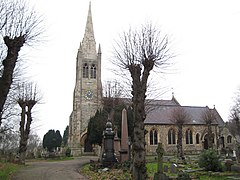Buckhurst Hill
| Buckhurst Hill | |
|---|---|
 The parish church of St John the Baptist was built in 1838 | |
| Population | 10,738 |
| OS grid reference | TQ415935 |
| • London | 10.7 mi (17.2 km) SW |
| Civil parish |
|
| District | |
| Shire county | |
| Region | |
| Country | England |
| Sovereign state | United Kingdom |
| Post town | BUCKHURST HILL |
| Postcode district | IG9 |
| Dialling code | 020 |
| Police | Essex |
| Fire | Essex |
| Ambulance | East of England |
| UK Parliament | |
| Website | www |
Buckhurst Hill is an affluent suburban town in the Epping Forest district of Essex, England. Located adjacent to the northern boundary of Greater London, it forms part of the Greater London Urban Area. The railway line was opened in 1856 as part of the Eastern Counties Railway and it is the middle-class development that resulted from this line that gives Buckhurst Hill its typical Victorian ambience.
History
The first mention of Buckhurst Hill is in 1135, when reference was made to "La Bocherste", becoming in later years "Bucket Hill", originally meaning a hill covered with beech trees.[1] It lay in Epping Forest and consisted of only a few scattered houses along the ancient road from Woodford to Loughton. Before the building of the railways Buckhurst Hill was on the stage coach route between London and Cambridge, Norwich, Bury St Edmunds and Dunmow. Originally it was a part of the parish of Chigwell; there was no road connecting the two communities and in order to get to church, parishioners had to ford the River Roding at Woodford.[2] The Parish Church of St John was built in 1838 as a chapel of ease but did not become a separate ecclesiastical parish until 1867.[3] St John's National School was also built in 1838. The lord of the manor gave a site next to the church; the building cost £209, most of which was donated by the church congregation.[4] The opening of Buckhurst Hill Station in 1856 saw a rapid expansion in the population of the area; nearly six hundred new houses had been built near the station by 1871. Some of the land for this expansion was enclosed from Epping Forest, before this practice was halted by the Epping Forest Act, 1878.
The civil parish of Buckhurst Hill became Buckhurst Hill Urban District in 1894. In 1933, it was merged with the Chigwell and Loughton Urban District to form the Chigwell Urban District.[5] A further merger with Epping Urban District, Waltham Holy Cross Urban District and most of Epping and Ongar Rural District in 1974 brought Buckhurst Hill into Epping Forest District,[6] and in 1996, Buckhurst Hill Parish Council was established as a first tier of local government.[7]
Geography
It is at the western edge of Essex, 10.7 miles (17.2 km) northeast of Charing Cross and near to the boundary with the London Borough of Redbridge. Parts of Epping Forest are in Buckhurst Hill intermingled with residential areas. Nearest places are Chigwell, Chingford, Loughton and Woodford.
Transport
Buckhurst Hill is served by Buckhurst Hill tube station and Roding Valley tube station, which are on the Central Line of the London Underground. The line also operates to Loughton, Woodford and Epping. Also, from nearby Chingford Station, services can be used to reach London Liverpool Street via Walthamstow and Hackney. Bus service 397 can be used to reach Chingford Station. Most bus routes serving Buckhurst Hill are London Buses services (despite being outside the London Buses zone).
Culture
It was featured on the ITV1 series Essex Wives a programme about women in the area who were in business or fairly well-off. With Loughton and Chigwell, it is said to form part of the Essex golden triangle of wealthy places. Filming for The Only Way Is Essex takes place on Queens Road and at Belles & Beaus and Pet Couture. It is also home to Buckhurst Hill Football Club.
Famous residents
- Ed Byrne - comedian
- Aaron Lennon - footballer, Tottenham and England
- Jack Tweed - Television personality
- Jack Straw - politician
- Richard Crossman - politician
- Mark Wright TOWIE star and TV presenter
References
- ^ The Place-Names of Essex, Percy Hide Reaney, Cambridge University Press 1935
- ^ [A History of the County of Essex: Volume 4: Ongar Hundred. W R Powell (Editor), 1956 (pp 18–22) http://www.british-history.ac.uk/report.aspx?compid=15534]
- ^ W R Powell p 33
- ^ W R Powell p 40
- ^ W R Powell (pp 18–22)
- ^ Epping Forest District Council: History of the District
- ^ Buckhurst Hill Parish Council: About Buckhurst Hill
